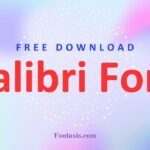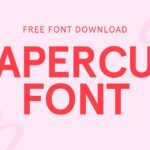Quick Summary
The “Nickelodeon Font” isn’t a single, officially named typeface. It refers to the iconic, bubbly, and playful sans-serif font most famously used in Nickelodeon’s branding, particularly its logo. Learning to find and use fonts that evoke this playful, energetic feel involves understanding its characteristics and exploring similar free and paid options.
Remember those Saturday mornings filled with vibrant cartoons and energetic themes? A big part of that unforgettable feeling was the way everything looked – especially the titles and logos. The “Nickelodeon Font” is that unmistakable style that instantly brings back waves of childhood nostalgia. It’s fun, it’s bold, and it’s instantly recognizable. But what exactly is this font, and how can you capture that same magic for your own projects? Many designers get stumped trying to pinpoint an official name or find the exact match. Don’t worry! We’re going to break down exactly what makes this font so special and guide you through finding and using fonts that have that iconic Nickelodeon vibe. Get ready to inject some serious fun into your designs!
Unpacking the “Nickelodeon Font” Vibe
When people talk about the “Nickelodeon Font,” they’re usually referring to the distinct typeface that splashed across our screens for decades. It’s characterized by its rounded, bubbly shapes and a sense of playful energy. Think of the classic Nickelodeon logo – that’s the core of what we’re exploring. It’s not one single font that’s been used forever without change, but rather a consistent style they’ve leaned into. This style is all about accessibility, fun, and a touch of silliness that appeals to a young audience, but also resonates with adults who grew up with it. It’s approachable, friendly, and far from stuffy. This is why it’s so popular for branding that wants to feel energetic and engaging.
Key characteristics of this iconic look include:
- Rounded Forms: The letters are soft and curved, with very few sharp edges. This gives them a friendly, approachable, and almost squishy appearance.
- Slightly Irregular Baseline (Sometimes): In some applications, especially older logos or more playful variations, the letters might appear to have a slightly uneven baseline, adding to the dynamic and whimsical feel.
- Bold and Chunky: The letterforms are typically thick and substantial, making them highly readable and impactful, even at smaller sizes.
- Sans-Serif Construction: It’s a sans-serif font, meaning it lacks the small decorative strokes (serifs) found at the ends of letters in fonts like Times New Roman. This modern, clean construction contributes to its readability.
- Playful Personality: The overall impression is cheerful, energetic, and fun – perfect for a children’s entertainment brand.
The Quest for the Exact Font: A Designer’s Detective Work
Finding the exact font used by Nickelodeon can be a bit of a treasure hunt. Over the years, they’ve used variations and perhaps even custom-modified typefaces. The original logo font is often cited as being derived from or heavily inspired by a font called “Balloon,” specifically the “Balloon EF” or “Balloon Ultra” variants. However, Balloon is a proprietary font, meaning it usually requires a license for commercial use.
The challenge for many beginners is that “Nickelodeon Font” isn’t a specific font name you can type into a search bar on a font foundry. It’s more of a descriptor for a style. This leads many designers to search for “Nickelodeon font free” or “font like Nickelodeon.” The good news is that there are many excellent fonts available that capture that same rounded, playful essence, often for free!
Why the “Nickelodeon” Style is So Appealing for Branding
The enduring appeal of the Nickelodeon font style is rooted in its ability to convey specific emotions and messages. For brands targeting families, children, or those wanting to project an image of fun and creativity, this style is a goldmine. It’s:
- Inviting: The roundness makes it feel welcoming and less formal.
- Energetic: The bold strokes and often playful design suggest dynamism and excitement.
- Memorable: Its strong, distinct characteristics make it easy to recall and associate with positive feelings.
- Readable: Despite its playfulness, the sans-serif structure ensures it’s easy to read on screen and in print, which is crucial for any successful brand.
This is why understanding the essence of the Nickelodeon font is more important than finding an exact replica. It’s about capturing the feeling it evokes.
Your Step-by-Step Guide to Finding and Using Nickelodeon-Style Fonts
Let’s dive into how you can find fonts that channel that beloved Nickelodeon spirit for your own projects. We’ll cover identifying the style, exploring options, and putting them to good use.
Step 1: Identify the Core Characteristics
Before you start searching, get clear on what makes the Nickelodeon font work. As we discussed, it’s all about:
- Rounded, soft letter edges.
- Bold and substantial letterforms.
- Sans-serif design for clarity.
- A generally upbeat and friendly personality.
Keep these elements in mind as you browse font libraries. This will help you weed out fonts that are too sharp, too thin, or too serious.
Step 2: Explore Font Resources
There are fantastic places online where you can find a vast array of fonts, both free and paid. Here are some highly recommended resources:
Free Font Resources:
- Google Fonts: A massive library of high-quality, open-source fonts available for free. Great for web design and everyday use.
- DaFont: A huge archive of free fonts, though quality can vary. It’s excellent for creative exploration and finding unique styles. Be sure to check licenses for commercial use.
- Font Space: Offers a curated collection of free fonts, many of which are suitable for commercial projects.
Paid Font Resources (for professional, licensed options):
- MyFonts: One of the largest marketplaces for commercial fonts.
- Fonts.com: Another reputable source for licensed typefaces.
- Adobe Fonts: If you have an Adobe Creative Cloud subscription, you get access to a vast library of high-quality fonts.
Step 3: Search with Smart Keywords
When you’re on these sites, don’t just type “Nickelodeon font.” Instead, use descriptive keywords that capture the essence:
- “Rounded sans serif”
- “Bubbly font”
- “Playful font”
- “Fun font”
- “Cartoon font”
- “Groovy font”
- “Bold rounded”
Combine these with the resource names while searching. For example, “Google Fonts rounded sans serif” or “DaFont bubbly font.”
Step 4: Preview and Test Fonts
Once you find a few candidates, it’s crucial to test them out. Most font sites allow you to type in your own text to preview how the font looks. Type your brand name, a tagline, or a catchy phrase. Pay attention to:
- Readability: Can you easily read it? Does it work for both headlines and body text?
- Character Spacing (Kerning): Do the letters look too far apart or too close together?
- Weight: Is it bold enough to make an impact without becoming too heavy?
- Overall Feel: Does it have that cheerful, energetic vibe you’re aiming for?
Step 5: Consider Font Licensing
This is super important, especially if you’re using fonts for a business or website. Free fonts often come with licenses that allow personal use, but commercial use might require attribution or a purchase. Paid fonts come with various licensing agreements outlining how you can use them (e.g., for web, print, app). Always check the license information!
For example, Google Fonts are generally under an Open Font License (OFL), which is very permissive and typically allows commercial use without attribution. However, fonts from sites like DaFont or FontSpace have diverse licenses, so careful checking is a must.
Step 6: Font Pairing – Adding Complementary Styles
A great design rarely uses just one font. You’ll want to pair your “Nickelodeon-style” font with other typefaces to create a balanced and professional look. Since your primary font will likely be a display or headline font with a lot of personality, you’ll want a more neutral, readable font for body text.
Good pairings often involve:
- A playful, rounded font for headlines/logos
- A clean, simple sans-serif or a classic serif font for body copy.
For example, if you choose a very bubbly font for your main title, consider pairing it with a font like Open Sans or Lato for your paragraphs. These are clean, highly readable sans-serifs that won’t compete with the flair of your headline font.
Recommended Fonts for That Nickelodeon Feel
Ready to see some specific examples? Here are a few fonts that capture that rounded, playful, and bold essence, categorized by where you can find them.
Free Font Recommendations
These are fantastic for getting that vibe without any cost. Remember to always double-check the license for your specific use case!
1. Baloo 2 (Google Fonts)
This font is often cited as one of the closest free alternatives. It’s designed with rounded letterforms and a friendly, open feel. It comes in multiple weights, offering good versatility.
2. Fredoka One (Google Fonts)
Fredoka One is delightfully chunky and rounded. It’s perfect for impactful headlines and titles where you want to convey a sense of fun and energy. Its uniformity makes it very readable.
3. Nunito (Google Fonts)
Nunito is a well-balanced sans-serif with rounded terminals. It feels modern, friendly, and very versatile. It’s excellent for both display text and longer passages if you choose its lighter weights.
4. Bubblegum Sans (Google Fonts)
As the name suggests, this font fully embraces the bubbly aesthetic. It’s playful and has a slightly more informal feel, great for projects that lean heavily into fun and whimsy.
5. Comic Neue (Free on various sites, check license)
While not identical, Comic Neue offers a clean, friendly, and slightly quirky take on a comic book style font, which shares some of the approachable, informal spirit of the Nickelodeon font.
Paid Font Alternatives & Similar Styles
If you’re willing to invest in a professional typeface for commercial projects or to achieve a very specific look, consider these:
1. Balloon Series (e.g., Balloon EF, Balloon Ultra)
As mentioned, this is often considered the grandparent of this style. If budget and licensing allow, these are the closest you’ll get to the original inspiration. They are a staple in many design software packages and font marketplaces like MyFonts.
2. Cooper Black
Though a serif font, Cooper Black shares the bold, rounded, and slightly groovy feel that was popular concurrent with the early explosion of fun, bold typefaces. It has a heavy, distinct personality and is instantly recognizable for its warmth and character.
3. Quicksand (Google Fonts, though a solid option often found also in paid libraries with more features)
While free, Quicksand is so well-designed with its geometric simplicity and rounded forms that it often feels like a premium font. It’s a fantastic choice for a clean modern look with a friendly edge.
Here’s a quick comparison of some free options:
| Font Name | Primary Characteristics | Best For | Typical Use Case |
|---|---|---|---|
| Baloo 2 | Rounded, open, friendly | Headlines, branding | Logos, titles, slogans that need to feel approachable and fun. |
| Fredoka One | Chunky, bold, very rounded | Impactful headlines, short text | Big titles, call-to-action buttons, key branding elements. |
| Nunito | Balanced, rounded terminals, versatile | UI elements, body text, subheadings | Web elements, small print, friendly app interfaces. |
| Bubblegum Sans | Very bubbly, informal, playful | Thematic titles, decorative use | Party invitations, kids’ event materials, playful banners. |
Putting It All Together: Design Best Practices
Once you’ve selected your font, remember these tips to make your design shine:
- Hierarchy: Use your chosen playful font for headlines or key branding elements. Reserve simpler, more readable fonts for body text. Understanding information hierarchy is key to guiding your reader’s eye.
- Contrast: Pair your bubbly font with something more neutral to create visual interest without overwhelming the reader.
- Color: Think about bright, vibrant colors that complement the energetic feel of the font.
- Context: Ensure the font’s personality matches your brand’s overall message.
Frequently Asked Questions (FAQ)
What is the actual name of the Nickelodeon font?
There isn’t one single, officially named “Nickelodeon Font.” The style most people refer to is inspired by fonts like Balloon EF and custom variations used historically for their branding, characterized by rounded, bubbly, sans-serif letterforms.
Can I use these fonts for commercial purposes?
For fonts found on Google Fonts or Adobe Fonts, yes, they are generally free to use for both personal and commercial projects. For fonts from sites like DaFont or Font Space, you MUST check the specific license for each font to ensure commercial use is permitted.
Are there any free fonts that look very similar to the Nickelodeon logo?
Yes! Fonts like Baloo 2, Fredoka One, Nunito, and Bubblegum Sans from Google Fonts are excellent free options that capture a similar rounded, playful, and bold aesthetic.
How do I choose a font for my logo?
For a logo, choose a font that is unique, memorable, and reflects your brand’s personality. Consider legibility at various sizes and ensure it scales well. A font with a distinct personality, like a rounded sans-serif, can be very effective.
What’s the difference between a serif and a sans-serif font?
Serif fonts have small decorative strokes (serifs) at the ends of letters (like in Times New Roman), often seen as traditional or formal. Sans-serif fonts lack these strokes (like Arial or the Nickelodeon style), appearing more modern, clean, and often friendlier.
Why is font readability so important?
Readability ensures your message is easily understood. If a font is too decorative, too small, or too complex, readers might struggle to get through your content, leading to frustration and a poor user experience. A good font is like a clear pathway for information.
Conclusion
The “Nickelodeon Font” style is a fantastic way to inject personality, fun, and youthful energy into your designs. By understanding its core characteristics – those delightful rounded shapes and bold, friendly forms – you can confidently navigate font libraries and discover excellent alternatives. Whether you opt for the free and fantastic offerings from Google Fonts like Baloo 2 and Fredoka One, or explore premium options, the goal is always to capture that distinctive, approachable vibe.
Remember to always check licensing, test your chosen fonts for readability and impact, and pair them smartly with complementary typefaces. With these steps, you’re well on your way to designing projects that are not only visually appealing but also radiate that unmistakable, joyful spirit. Happy designing!



